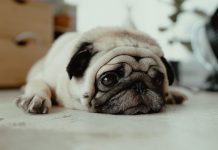Dog flipping dog bowl. That isn’t something you see every day, but it is something that is becoming more common among dogs. Flipping the dog bowl is an expression used to describe a behavior where dogs will turn their bowl over and eat from the floor instead of the bowl.
If your dog flips a dog bowl or any other type of food bowl, there are a few things you can do to stop it from happening again so that you and your furry companion can enjoy meal time together.
The reason why some dogs will flip their food bowls and eat from the floor has to do with how they were raised as a puppy. Dogs who were raised in an environment where they had to compete for their food are more likely to exhibit this behavior later on in life because it’s what they learned growing up.
However, with some redirection and tips on how to stop your dog from flipping the dog bowl, you can help prevent this behavior from continuing at home. Read on for more information on keeping your dog from flipping the food bowl and what to do if this continues to be an issue when feeding them.
How to stop your dog from flipping the dog bowl
One of the best tips on how to stop your dog from flipping the dog bowl is to feed them at the same times each day. By feeding them at the same times each day, you are making it easier for your dog to know when to expect their next meal and will help you keep track of when they should be eating.
If your dog is eating from an open food bowl, try switching to a dog bowl with a lid. This will make it harder for them to flip their bowl over. While you’re at it, you could try switching to a dog bowl with a divider inside. This will make it so that your dog can’t flip the bowl over at all, and they will have to sit still while they eat instead of moving the bowl around.
Don’t Leave Bowls of Food Out All Day
If you have a dog who is prone to flipping their bowl, you should never leave their bowl of food out. This will just give your dog an opportunity to flip their bowl over and eat from the floor. Instead, you should put your dog’s food bowl away as soon as they have finished eating. If you leave their bowl out, it will be easy for your dog to flip it over and eat from the floor.
By putting the dog bowl away as soon as your dog has finished eating, you are preventing them from having easy access to the food bowl and making it harder for them to flip it over. When it comes to how long you should leave the dog bowl out for your dog, it varies based on their size. Small dogs can go anywhere from 15 minutes to an hour, while larger dogs could go anywhere from two hours to eight hours.
Don’t Use Bowls With High Edges
If your dog is the type that likes to flip their food bowl over and eat from the floor, you should avoid getting bowls with high edges.
When you have a dog bowl with high edges, it makes it easier for your dog to flip it over, and they will likely do this if they are more comfortable eating on the floor. Instead, you should use a low-sided bowl with no edges so that it’s harder for your dog to turn the bowl over.
This will make it harder for your dog to flip the bowl and will make them more comfortable eating in the bowl instead of from the floor. By switching to dog bowls with low edges and no edges, it will be harder for your dog to flip the bowl over, and they will have to sit still while eating instead of turning the bowl over.
Rotate Where You Place Your Dog’s Bowl
If your dog is the type to flip their bowl every time, you could try rotating where you place their bowl. This will help prevent your dog from becoming too accustomed to eating in one spot and will make it harder for them to flip the bowl over. When you rotate where you place your dog’s bowl, they will have to search for their bowl, and this will give them something else to focus on.
This can help deter your dog from flipping their bowl over since they have to work a little harder to find their food. By rotating where you place your dog’s bowl, they will have to look for it each time they are fed and will have to focus on finding their bowl instead of flipping it over.
Don’t Leave Food in the Bowl for Long Periods of Time
Another way to prevent your dog from flipping the dog bowl is to make sure that you don’t leave food in the bowl for long periods of time. By leaving food in the bowl for long periods of time, it gives your dog an opportunity to flip the bowl over and will make it easier for them to do this. Instead, you should take the food bowl away from your dog as soon as they are done eating.
This will make it harder for your dog to flip the bowl over and will make it easier for you to clean up the mess. By taking the food bowl away from your dog as soon as they are done eating, you are making it harder for your dog to flip their bowl and will help prevent them from doing this in the future.
Try Different Types of Food Bowls
If your dog is the type to flip the dog bowl no matter what you do, you could try switching the type of food bowl you are using. Certain types of food bowls are easier to flip over than others, and you could try switching to a different bowl. There are many different types of dog bowls on the market today, and you could try switching to a different bowl and see if it makes a difference.
You could try switching to a food bowl with a lid or a food bowl with a divider inside. These will make it harder for your dog to flip the bowl over and will make them sit still while they eat instead of moving the bowl around.
Conclusion
If your dog is the type to flip the dog bowl over and eat from the floor, you can help prevent this by making it harder for them to flip the bowl over. You can do this by feeding your dog at the same times each day, removing the bowl as soon as they are done eating, rotating where you place their bowl, and by using different types of food bowls.
Keep in mind that dogs are individuals, and what works for one dog may not work for another. You should look out for signs that your dog is distressed or anxious and make sure to seek the advice of a veterinarian if you notice your dog has behavioral issues.











